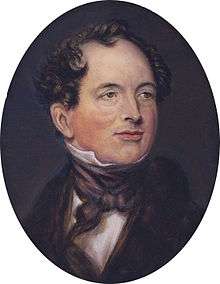Lalla-Rookh

Lalla Rookh is an Oriental romance by Thomas Moore, published in 1817. The title is taken from the name of the heroine of the frame tale, the daughter of the 17th-century Mughal emperor Aurangzeb. The work consists of four narrative poems with a connecting tale in prose.
Overview
The name Lalla Rookh or Lala-Rukh (Persian: لاله رخ lâle rox), means "tulip cheeked" and is an endearment frequently used in Persian poetry.[2]
Engaged to the young king of Bukhara, Lalla Rookh goes forth to meet him, but falls in love with Feramorz, a poet from her entourage. The bulk of the work consists of four interpolated tales sung by the poet: "The Veiled Prophet of Khorassan" (loosely based upon the story of Al-Muqanna), "Paradise and the Peri", "The Fire-Worshippers", and "The Light of the Harem". When Lalla Rookh enters the palace of her bridegroom she swoons away, but revives at the sound of a familiar voice. She awakes with rapture to find that the poet she loves is none other than the king to whom she is engaged.[3]
Adaptations
Lalla Rookh was the basis of number of musical settings, including the song I'll Sing Thee Songs of Araby by Frederic Clay & W. G. Wills (1877).[4] It is also the basis of the operas Lalla-Rûkh, festival pageant (1821) by Gaspare Spontini, partly reworked into Nurmahal oder das Rosenfest von Caschmir (1822), Lalla-Roukh by Félicien David (1862), Feramors by Anton Rubinstein (1863), and The Veiled Prophet by Sir Charles Villiers Stanford (1879). One of the interpolated tales, Paradise and the Peri, was set as a choral-orchestral work by Robert Schumann (1843). Lines from the poem form the lyrics of the song "Bendemeer Stream".
Legacy
Mystic Order of Veiled Prophets of the Enchanted Realm (founded 1889), often known as "the Grotto", a social group with membership restricted to Master Masons, and its female auxiliary, the Daughters of Mokanna (founded 1919), also take their names from Thomas Moore's poem.[5] [6]
References
- ↑ Schimmel, A.; Waghmar, B.K. (2004). The Empire of the Great Mughals: History, Art and Culture. Reaktion Books. p. 17. ISBN 9781861891853. Retrieved 3 October 2014.
- ↑ Balfour, Edward (1885). The Cyclopædia of India and of Eastern and Southern Asia. II. London: Bernard Quaritch. p. 661.
- ↑
 Wood, James, ed. (1907). "Lalla-Rookh". The Nuttall Encyclopædia. London and New York: Frederick Warne.
Wood, James, ed. (1907). "Lalla-Rookh". The Nuttall Encyclopædia. London and New York: Frederick Warne. - ↑ Michael Kilgariff (1998) Sing Us One of the Old Songs: A Guide to Popular Song 1860–1920
- ↑ The Grotto, MasonicDictionary.com, 2007, retrieved 2009-12-15
- ↑ Lalla Rookh Caldron, Daughters of Mokanna, Lalla Rookh Grotto, retrieved 2009-12-15
External links
http://www.bartleby.com/library/poem/3665.html
- Lalla Rookh prepared for the web by Fran Pritchett
- Thomas Moore (1817). Lalla Rookh: An Oriental Romance. Thomas Y. Crowell & Company.
- The Complete Poems of Sir Thomas Moore, including Lalla Rookh
